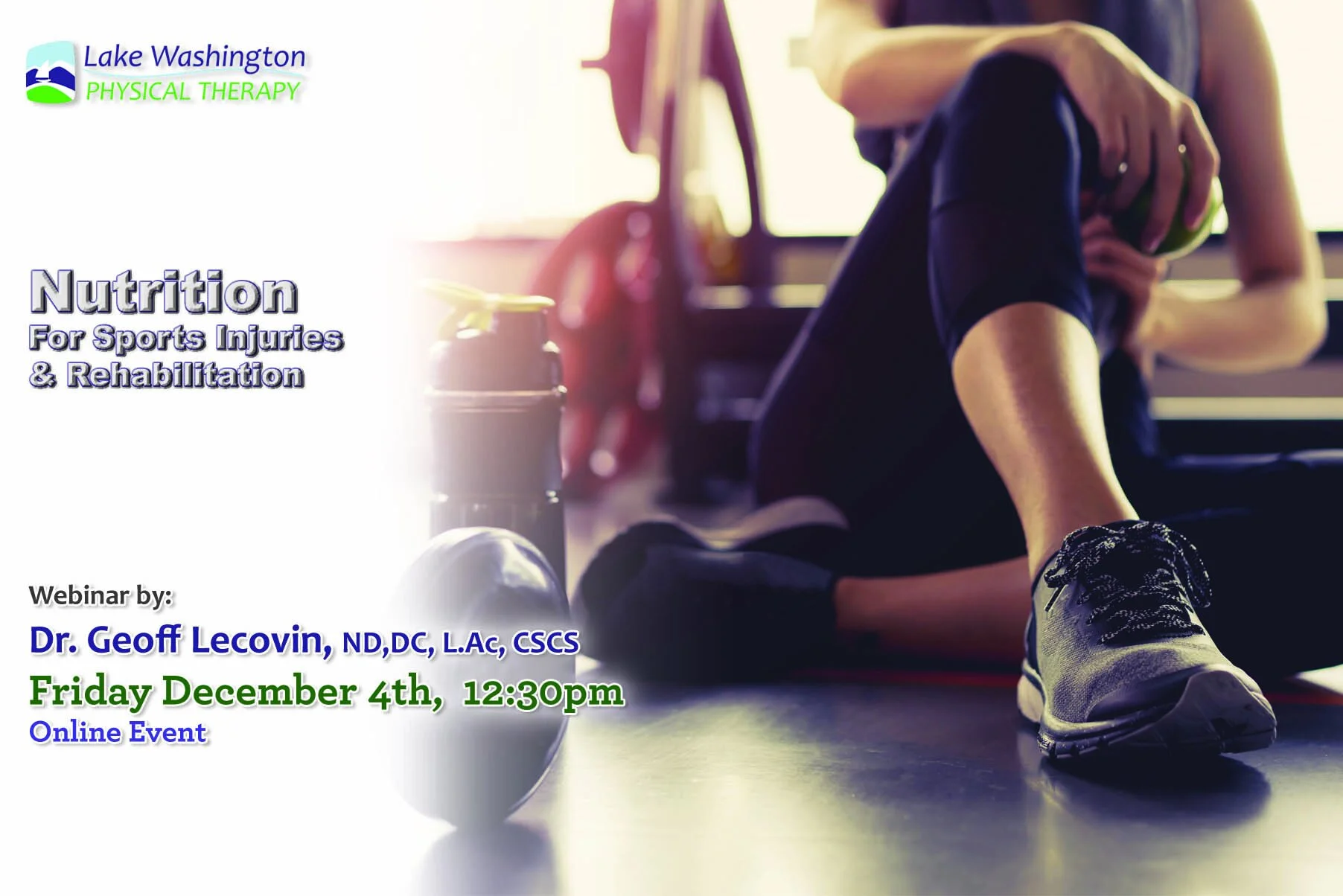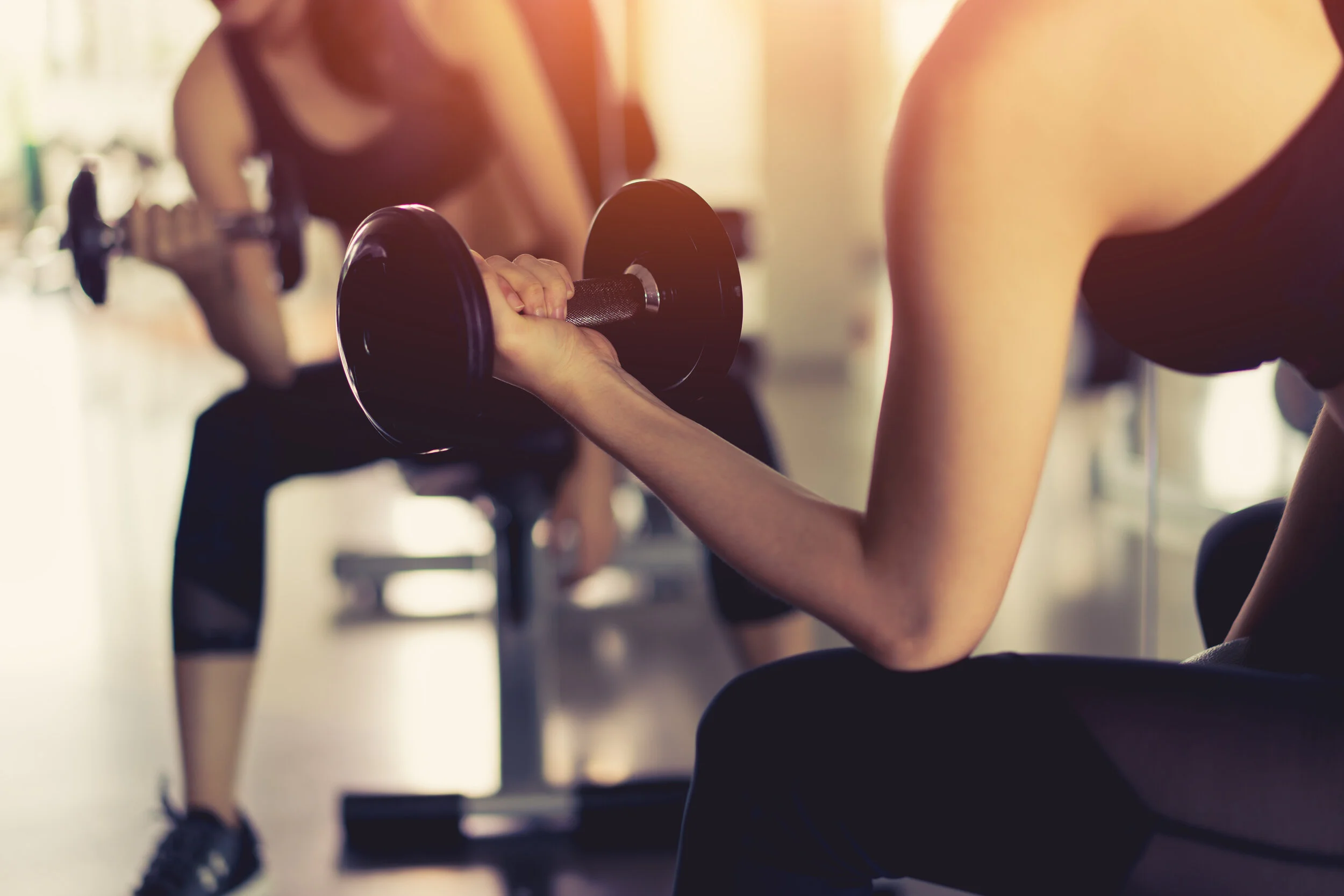Nutrition for Sports Injuries & Healing: 1 of 3
Dr. Geoff Lecovin
MS, DC, ND, L.Ac, CSCS, CISSN
Naturopathic Physician, Chiropractor, Acupuncturist, Nutritionist, & Personal Trainer
“Unleashing the Power of Food”
Healing after an Injury occurs in three stages
1. Inflammation - Occurs immediately and continues up to 5 days post-injury. It is the body's way of signaling the immune system to heal and repair damaged tissue, as well as defend itself against viruses and bacteria.
2. Proliferation (regeneration) - From 5 days to 3 weeks post-injury. In this phase, tissue rebuilding and repairing occurs.
3. Maturation (fibrosis) - From 3 weeks to 2 years. In this phase, remodeling of tissue structure occurs. Each stage must occur sequentially in order for optimal healing to occur. By understanding the stages of healing, one can more effectively focus specific nutrition and rehabilitation interventions. Should you use ice and/or anti-inflammatory medications after an injury?
Healing after an Injury occurs in three stages
1. Inflammation - Occurs immediately and continues up to 5 days post-injury. It is the body's way of signaling the immune system to heal and repair damaged tissue, as well as defend itself against viruses and bacteria.
2. Proliferation (regeneration) - From 5 days to 3 weeks post-injury. In this phase, tissue rebuilding and repairing occurs.
3. Maturation (fibrosis) - From 3 weeks to 2 years. In this phase, remodeling of tissue structure occurs. Each stage must occur sequentially in order for optimal healing to occur. By understanding the stages of healing, one can more effectively focus specific nutrition and rehabilitation interventions. Should you use ice and/or anti-inflammatory medications after an injury?
During the inflammatory stage, numerous chemicals are released, some of which can irritate pain receptors called nociceptors. Many people turn to Non Steroidal Anti-inflammatory Drugs, such as Ibuprofen and Naproxen, to reduce the pain. Unfortunately, while these medications can be effective at blocking pain, they can also disrupt the healing process. Fortunately, there are a number of alternative physical and nutritional interventions that can help reduce the pain associated with inflammation, while at the same time supporting the healing process.
MEAT vs RICE?
Move, Exercise, Analgesics, Treatment
Rest, Ice, Compression, Elevation
MEAT supports the healing process, whereas certain aspects of RICE may impede it, depending upon the injury. I generally recommend contrast hydrotherapy as follows: Three minutes of heat alternating with one minute cold, three times, several times throughout the day. This serves to pump nutrition into the injured area and pump waste products out. Ice is generally reserved for right after surgery or briefly after an injury, depending on the severity of the inflammation. You should consult your doctor or therapist to determine which approach best suits your injury.
References:
Areestion during prolta, J. L., Burke, L. M., Ross, M. L., Camera, D. M., West, D. W., Broad, E. M., ... & Hawley, J. A. (2013).
Timing and distribution of protein ingonged recovery from resistance exercise alters myofibrillar protein synthesis. The Journal of physiology , 591 (9), 2319-2331 Louise M. Burke, John A. Hawley, Stephen H. S. Wong & Asker E. Jeukendrup (2011)
Carbohydrates for training and competition, Journal of Sports Sciences, 29:sup1, S17-S27, DOI: 10.1080/02640414.2011.585473 Clifford, T., Bell, O., West, D. J., Howatson, G., & Stevenson, E. J. (2016).
The effects of beetroot juice supplementation on indices of muscle damage following eccentric exercise. European journal of applied physiology , 116 (2), 353-362. Close, G. L., Sale, C., Baar, K., & Bermon, S. (2019).
Nutrition for the prevention and treatment of injuries in track and field athletes. International journal of sport nutrition and exercise metabolism , 29 (2), 189-197 Currell , Kevin. Performance Nutrition . Crowood Press (April 1, 2017)
Farup, J., Rahbek, S. K., Knudsen, I. S., de Paoli, F., Mackey, A. L., & Vissing, K. (2014). Whey protein supplementation accelerates satellite cell proliferation during recovery from eccentric exercise. Amino Acids , 46 (11), 2503-2516 Frankenfield, D. (2006).
Energy expenditure and protein requirements after traumatic injury. Nutrition in Clinical Practice , 21 (5), 430-437 Glover, E. I., Phillips, S. M., Oates, B. R., Tang, J. E., Tarnopolsky, M. A., Selby, A., ... & Rennie, M. J. (2008).
Immobilization induces anabolic resistance in human myofibrillar protein synthesis with low and high dose amino acid infusion. The Journal of physiology , 586 (24), 6049-6061 Guo, S., & Dipietro, L. A. (2010).
Factors affecting wound healing. Journal of dental research , 89 (3), 219–229. https://doi.org/10.1177/0022034509359125 Juhasz, I., Kopkane, J. P., Hajdu, P., Szalay, G., Kopper, B., & Tihanyi, J. (2018).
Creatine Supplementation Supports the Rehabilitation of Adolescent Fin Swimmers in Tendon Overuse Injury Cases. Journal of sports science & medicine , 17 (2), 279–288 Kelley, D. S., Adkins, Y., & Laugero, K. D. (2018).
A Review of the Health Benefits of Cherries. Nutrients , 10 (3), 368. https://doi.org/10.3390/nu10030368 Kerksick, C. M., Arent, S., Schoenfeld, B. J., Stout, J. R., Campbell, B., Wilborn, C. D., Taylor, L., Kalman, D., Smith-Ryan, A. E., Kreider, R. B., Willoughby, D., Arciero, P. J., VanDusseldorp, T. A., Ormsbee, M. J., Wildman, R., Greenwood, M., Ziegenfuss, T. N., Aragon, A. A., & Antonio, J. (2017).
International society of sports nutrition position stand: nutrient timing. Journal of the International Society of Sports Nutrition , 14 , 33. https://doi.org/10.1186/s12970-017-0189-4 Laumonier, T., & Menetrey, J. (2016).
Muscle injuries and strategies for improving their repair. Journal of experimental orthopaedics , 3 (1), 15. https://doi.org/10.1186/s40634-016-0051-7 Logue, D. M., Madigan, S. M., Melin, A., Delahunt, E., Heinen, M., Donnell, S. M., & Corish, C. A. (2020). Low Energy Availability in Athletes 2020:
An Updated Narrative Review of Prevalence, Risk, Within-Day Energy Balance, Knowledge, and Impact on Sports Performance. Nutrients , 12 (3), 835. https://doi.org/10.3390/nu12030835 Phillips, C. M., Chen, L. W., Heude, B., Bernard, J. Y., Harvey, N. C., Duijts, L., ... & Shivappa, N. (2019).
Dietary inflammatory index and non-communicable disease risk: a narrative review. Nutrients , 11 (8), 1873. Maughan, R. J., Burke, L. M., Dvorak, J., Larson-Meyer, D. E., Peeling, P., Phillips, S. M., ... & Meeusen, R. (2018).
IOC consensus statement: dietary supplements and the high-performance athlete. International journal of sport nutrition and exercise metabolism , 28 (2), 104-125 Myer, G. D., Kushner, A. M., Brent, J. L., Schoenfeld, B. J., Hugentobler, J., Lloyd, R. S., Vermeil, A., Chu, D. A., Harbin, J., & McGill, S. M. (2014).
The back squat: A proposed assessment of functional deficits and technical factors that limit performance. Strength and conditioning journal , 36 (6), 4–27. https://doi.org/10.1519/SSC.0000000000000103 Mountjoy, M., Sundgot-Borgen, J., Burke, L., Carter, S., Constantini, N., Lebrun, C., ... & Ljungqvist, A. (2014).
The IOC consensus statement: beyond the female athlete triad—Relative Energy Deficiency in Sport (RED-S). Br J Sports Med , 48 (7), 491-497 Pence, B. D., & Woods, J. A. (2014). Exercise, obesity, and cutaneous wound healing: evidence from rodent and human studies. Advances in wound care , 3 (1), 71-79. Quintero, K. J., de Sá Resende, A., Leite, G. S. F., & Junior, A. H. L. (2018).
An overview of nutritional strategies for recovery process in sports-related muscle injuries. Nutrire , 43 (1), 27 Sale, C., & Elliott-Sale, K. J. (2019). Nutrition and athlete bone health. Sports Medicine , 1-13 Shaw, G., Lee-Barthel, A., Ross, M. L., Wang, B., & Baar, K. (2017).
Vitamin C–enriched gelatin supplementation before intermittent activity augments collagen synthesis. The American journal of clinical nutrition , 105 (1), 136-143 Smith, Stephen, MSc, PHd, (Cand), NUTRITION FOR INJURY PREVENTION & REHABILITATION applied in an elite powerlifter.2019.
IOPN Performance Nutrition DiplomaTipton, K. D. (2015).
Nutritional support for exercise-induced injuries. Sports Medicine , 45 (1), 93-104 Van Vliet, S., Shy, E. L., Abou Sawan, S., Beals, J. W., West, D. W., Skinner, S. K., ... & Moore, D. R. (2017).
Consumption of whole eggs promotes greater stimulation of postexercise muscle protein synthesis than consumption of isonitrogenous amounts of egg whites in young men. The American journal of clinical nutrition , 106 (6), 1401-1412 Wall, B. T., Snijders, T., Senden, J. M., Ottenbros, C. L., Gijsen, A. P., Verdijk, L. B., & van Loon, L. J. (2013). Disuse impairs the muscle protein synthetic response to protein ingestion in healthy men. The Journal of Clinical Endocrinology & Metabolism , 98 (12), 4872-4881 Yang, D. F., Shen, Y. L., Wu, C., Huang, Y. S., Lee, P. Y., Er, N.X., ... & Tung, Y. T. (2019).
Sleep deprivation reduces the recovery of muscle injury induced by high-intensity exercise in a mouse model. Life sciences , 235 , 116835 Precision Nutrition, Nutrition for Injury Recovery Infographic. https://www.precisionnutrition.com/ http://www.sportsrd.org/wp-content/uploads/2016/08/Nutrition- Support-for-Inury-Recovery-Return-to-Play.pdf
Questions and Contact Info: www.drgeofflecovin.com or email: geoff@drgeofflecovin.com




